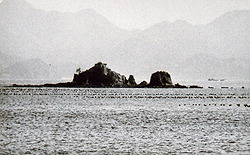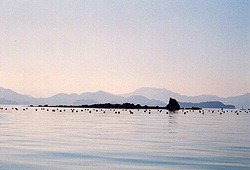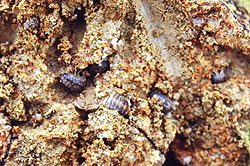The rocky Hoboro Island has become a breeding ground for huge numbers of creatures known in Japanese as nanatsuba-kotsubumushi, a type of isopod. The surging number of insects has caught the attention of local researchers.
"It's rare, even on a global scale, to hear of biological erosion that has proceeded on such a large scale and at such a rapid pace as to alter the landscape of an island," said Yuji Okimura, an emeritus professor at Hiroshima University.

|
| ©Hiroshima University emeritus professor Yuji Okimura |
| A photograph of Hoboro Island taken between about 1955 and 1965. |
According to land records of Hoboro Island compiled in 1928, the island was 120 meters long, and its highest point stood 21.9 meters above sea level. In a photo taken between about 1955 and 1965, the island had two rocky peaks, and vegetation was growing on the highest of the peaks.
Now, however, the highest peak has almost completely vanished, leaving only one rocky protrusion about 6 meters high. Because of this, most of the island is submerged at full tide.

|
| ©Yuji Okimura |
| A recent photograph of Hoboro Island. |
Local residents had said the island was getting smaller every time a typhoon passed through. Last year, Okimura and other researchers conducted an investigation of the island. They found countless nanatsuba-kotsubumushi bugs, which were making many holes in the rock as they built nesting areas. The island is formed from tuff, a type of rock that consists of volcanic ash, and the holes that the crustaceans have made have left the island exposed, allowing the sea to wash away the rock, researchers found.

|
| ©Yuji Okimura |
| Nanatsuba-kotsubumushi crustaceans dig holes in the rock on the island. |
The same phenomenon has not been observed at other nearby islands.
"I guess the nature of the terrain on Hoboro Island is soft, which makes it easy to dig holes, and on top of that there is an abundance of food for nanatsu-kotsubumushi," Okimura said.



Reader Comments
to our Newsletter